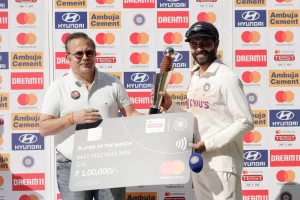India’s left-handers, Ravindra Jadeja and Axar Patel, batted nearly 60 overs on a surface that was supposedly tailormade to trouble Australia’s lefties. The visitors need to go back to basics to rebound from this disaster

This abbreviated Test in Nagpur was Australia’s 15th on Indian soil in nearly 15 years. Of those, they have won one, at Pune in the series opener in 2017. There have been 11 defeats. Test cricket, a format that’s taken seriously by less than half a dozen countries, desperately needs its rivalries to survive. And if the Border-Gavaskar trophy is to be viewed as a contest second only to the Ashes, then Australia’s cricketers will need to summon up far more than this apology of a performance.
At Mumbai in November 2004, another Test match ended inside three days. On that occasion, chasing 107 for victory, Australia were skittled for 93 in 30.5 overs. Years from now, there is a danger that some impressionable soul will compare that scorecard to this – 91 all out in 32.3 overs – and conclude that the two pitches were similar. They couldn’t be more wrong.
That Wankhede Stadium pitch truly was a spitting cobra, a minefield, a dustbowl. An Indian side boasting Virender Sehwag, Rahul Dravid, Sachin Tendulkar and VVS Laxman was bowled out for 104 in the first innings. Only the fact that Laxman (69) and Tendulkar (55) then crafted two of the finest innings seen in testing conditions allowed India to even set Australia a target. Nathan Hauritz took 3 for 16 in the first innings. Michael Clarke mopped up India’s resistance with 6-9 in the second.

There was no such drama in Nagpur in 2023. India batted 139.3 overs in their only innings. The eighth-wicket partnership between Ravindra Jadeja and Axar Patel alone lasted 35.1 overs, longer than the Australian second innings. Mohammed Shami saw off 47 balls for his 37, while also smashing three sixes. In Australia’s second dig, only Steven Smith managed to face more deliveries.
The pitch had been strategically watered and kept dry to stymie Australia’s left-handers, we were told. Someone must have forgotten to give the memo to Jadeja and Axar. India’s two left-handers batted 359 balls for a combined tally of 154 runs. If there is some special technique at work whereby the pitch can neutralize only the left-handers on one team, then the curator is truly a genius and must be commended.

So, let’s get past all the bovine excreta and pathetic excuses and deal instead in cold, hard facts. Australia were out-skilled by a massive margin in Nagpur. India bowled far better, and the batting, especially from Rohit Sharma, Jadeja and Axar was streets ahead of anything Australia could summon up. India were far sharper with the use of the Decision Review System (DRS) as well, starting with the inspired decision to query the not-out call in favour of Usman Khawaja on the first morning.
Travis Head may have an indifferent record so far in Asia, but it was a massive call to leave out a batsman who looked to be one of Australia’s most capable in the recent home summer. Matt Renshaw may have had experience of playing in India before, but it’s not as though his record is a stellar one either. And Head could definitely have asked questions with his off-spin, in a game where Nathan Lyon was comprehensively outbowled by Todd Murphy, the debutant.
It’s a mystery why teams, coaches and captains alike seem to think that funky tactics are the way to win in India, especially when there is zero evidence to support this view. The last touring team to win in India, England in 2012, did so because Alastair Cook batted with the concentration and skill that Indian pitches demand. Cook wouldn’t know what funky is if he tripped and fell over it. He defended diligently, put away the loose balls and made best use of the lucky breaks that came his way. Nothing funky there. Move on.
Or think back to Australia’s last series win on Indian soil. In the opening Test in Bangalore, Damien Martyn – raised on the fast and bouncy pitches of Western Australia – plonked his front foot forward and prodded an Anil Kumble delivery straight to Aakash Chopra at bat-pad. A shot played with hard hands, the entire sequence was an object lesson in how NOT to play in India.
Martyn, one of the world’s most beautiful batsmen to watch, absorbed those lessons quickly. For the rest of the tour, he played the ball as late as possible. Often deep in the crease, he would watch the ball almost on the blade before using his wrists to deflect it away. In the second Test in Chennai, Australia were 145 for 4 in their second innings – just four runs ahead – when Jason Gillespie joined him in the middle.
When you look back at that series, it’s customary to pinpoint Australia’s bowling dry – given the Indian batsmen next to no width to hit boundaries – as the main reason for their success. Indian supporters will point to the rain on the final day in Chennai, which prevented their team from chasing a gettable target.
But that the game went into day five in the first place was because of Martyn’s class. His century, and 139-run stand with Gillespie, transformed the match and series, and he would follow that up with 114 and 97 in Nagpur as Australia sealed the series. Even in Mumbai, it was his masterful 55 in the first innings that gave Australia what should have been a decisive first-innings lead.
Did Martyn try to sweep nearly every ball he faced? Did he attempt any ugly reverse-sweeps? You can guess the answer. He respected the conditions, the skills of the bowlers he was up against, and adjusted his batting accordingly. That’s common sense, and it’s the only way to win Test matches in India.
Before the next Test in Delhi, Australia’s batsmen need to stop obsessing about the surface and pay more attention to their skills. Get right forward or right back, use the straight bat, employ the sweep judiciously and shelve high-risk funky strokes that seldom come off. Thinking out of the box can sometimes be a good thing. But in sport, it’s most important to think clearly. Only one team did that in Nagpur. Use




